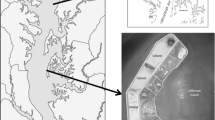Abstract
Windmill Point (WP) is an 8-ha dredged material island site in the intertidal reach of the James River. This fine-textured, freshwater site was one of the first habitat development projects built by the U. S. Army Corps of Engineers (CE). Long-term physical, chemical, and biological monitoring has been conducted since 1974. Three nearby natural wetlands have been used for comparison purposes in order to document site success or failure and the speed of wetland development. With the exception of some herbaceous plantings on the WP containment dikes, vegetation has colonized naturally. Over time, predominant species have beenPeltandra virginica, Pontederia cordata, andSagittaria latifolia. Wild-life and fish populations and species diversity have been consistently greater at WP than at the 3 reference wetlands. Benthos regained pre-disposal levels within 6 months. Five heavy metals and 14 PCBs were examined in soil and plant samples. Only DDE was found to translocate to wetland plant shoots, and kepone was found to be relatively stable. WP was broken into 2 smaller islands by flooding in 1983 and now consists of as much shallow aquatic habitat as emergent wetlands. The CE recognizes that active site management of such riverine wetlands through placement of additional dredged material and dike repair is needed to ensure long-term site integrity.
Similar content being viewed by others
Literature Cited
Adams, D.D., D. Darby, and R.J. Young. 1978. Windmill Point Marsh Development Site, James River, Virginia. Appendix F: Sediment and Water Quality. Volumes I and II. U.S. Army Engineer Waterways Experiment Station, Vicksburg, MS, U.S.A. TR D-77-23. NTIS No. AD-A066 224.
Boesch, D. F., R. J. Diaz, D. Doumlele, J. L. Hauer, M. Hedgepeth, J. V. Merriner, K. Munson, S. Powers, G. Silberhom, C. A. Stone, M. Wass, R. Wetzel, and E. Wilkins. 1978. Windmill Point Marsh Development Site, James River, Virginia. Appendix D: Botany, Soils, Aquatic Biology, and Wildlife. U. S. Army Engineer Waterways Experiment Station, Vicksburg, MS, U.S.A. TR D-77-23. NITS No. AD-A066 223.
Cheng, Y. K. and E. E. Whitehurst. 1984. Open Water Disposal for Marsh Creation, James River, Virginia. p. 926–935.In Dredging ’84 Conference, Clearwater Beach, FL. American Society of Civil Engineers, New York, NY, U.S.A.
Diaz, R. J. and D. F. Boesch. 1978. Windmill Point Marsh Development Site, James River, Virginia. Appendix C: Acute Impacts on the Macrobenthic Community. U.S. Army Engineer Waterways Experiment Station, Vicksburg, MS, U.S.A. TR D-77-23. NTIS No. AD-A066 224.
Environmental Laboratory. 1978. Wetland Habitat Development with Dredged Material: Engineering and Plant Propagation. TRDS-78-16. U. S. Army Engineer Waterways Experiment Station, Vicksburg, MS, U.S.A. TR DS-78-16. N TIS No. AD-A073 493.
Garbisch, E. W. Jr. 1978. Windmill Point Marsh Development Site, James River, Virginia. Appendix B: Propagation of Vascular Plants. U. S. Army Engineer Waterways Experiment Station, Vicksburg, MS, U.S.A. TR D-77-23. NTIS No. AD-A041 464.
Landin, M. C. 1984. Habitat Development Using Dredged Material. p. 907–918.In Dredging ’84 Conference, Clearwater Beach, FL. American Society of Civil Engineers, New York, NY, U.S.A.
Landin, M. C., J. W. Webb, and P. L. Knutson. 1989. Long-Term Monitoring of Eleven Corps of Engineer Habitat Development Field Sites Built of Dredged Material, 1974–1987. U.S. Army Engineer Waterways Experiment Station, Vicksburg, MS, U.S.A. TR D-89-01.
Lunz, J. D. 1978. Windmill Point Marsh Development Site, James River, Virginia. Appendix E: Metals and Chlorinated Hydrocarbon Compounds in Marsh Soils and Vascular Plant Tissues. U.S. Army Engineer Waterways Experiment Station, Vicksburg, MS, U.S.A. TR D-77-23. NTIS No. AD-A066 224.
Lunz, J. D., T. W. Ziegler, R. T. Huffman, R. J. Diaz, E. J. Clairain Jr., and L.J. Hunt. 1978. Windmill Point Marsh Development Site, James River Virginia: Summary Report. U. S. Army Engineer Waterways Experiment Station, Vicksburg, MS, U.S.A. TR D-77-23. NTIS No. AD-A066 224.
Newling, C. J. and M. C. Landin. 1985. Long-Term Monitoring of Habitat Development at Upland and Wetland Dredged Material Disposal Sites, 1974–1982. U. S. Army Engineer Waterways Experiment Station, Vicksburg, MS, U.S.A. TR D-85-5. NTIS No. AD-A159 106.
Silberhorn, G. M. and T.A. Barnard Jr. 1978. Windmill Point Marsh Development Site, James River, Virginia. Appendix A: Assessment of Vegetation on Existing Dredged Material Island. U. S. Army Engineer Waterways Experiment Station, Vicksburg, MS, U.S.A. TR D-77-23. NTIS No. AD-A066 224.
US Army Corps of Engineers. 1986. Dredged Material Beneficial Uses. Office, Chief of Engineers, Washington, DC. Engineer Manual 1110-2-5026. (also permanently available from U. S. Army Engineer Waterways Experiment Station, Vicksburg, MS, U.S.A.).
Author information
Authors and Affiliations
Rights and permissions
About this article
Cite this article
Landin, M.C., Clairain, E.J. & Newling, C.J. Wetland habitat development and long-term monitoring at Windmill Point, Virginia. Wetlands 9, 13–25 (1989). https://doi.org/10.1007/BF03160765
Issue Date:
DOI: https://doi.org/10.1007/BF03160765




